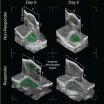(Press-News.org) Luis Hueso, the CICnanoGUNE researcher, together with researchers from the University of Cambridge, among others, has developed a new technology in the magnetic cooling of chips based on the straining of materials. Compared with the current technologies, this advance enables the impact on the environment to be lessened. The work has been published recently in the prestigious journal Nature Materials.
Current cooling systems, be they refrigerators, freezers or air conditioning units, make use of the compression and expansion of a gas. When the gas is compressed, it changes into a liquid state and when it expands it evaporates once again. To evaporate, it needs heat, which it extracts from the medium it touches and that way cools it down. However, this system is harmful for the environment and, what is more, the compressors used are not particularly effective.
One of the main alternatives that is currently being explored is magnetic cooling. It consists of using a magnetic material instead of a gas, and magnetizing and demagnetizing cycles instead of compression-expansion cycles. Magnetic cooling is a technique based on the magnetocaloric effect, in other words, it is based on the properties displayed by certain materials to modify their temperature when a magnetic field is applied to them. However, the applying of a magnetic field leads to many problems in current miniaturized technological devices (electronic chips, computer memories, etc.), since the magnetic field can interact negatively owing to its effect on nearby units. In this respect, the quest for new ways of controlling the magnetization is crucial.
Magnetism without magnetic fields
The researchers Luis Hueso, Andreas Berger and Odrej Hovorka of nanoGUNE have discovered that by using the straining of materials, they can get around the problems of applying a magnetic field. "By straining the material and then relaxing it an effect similar to that of a magnetic field is created, thus inducing the magnetocaloric effect responsible for cooling," explains Luis Hueso, leader of the nanodevices group at nanoGUNE and researcher in this study.
"This new technology enables us to have a more local and more controlled cooling method, without interfering with the other units in the device, and in line with the trend in the miniaturization of technological devices," adds Hueso.
20-nanometre films consisting of lanthanum, calcium, manganese and oxygen (La0.7Ca0.3MnO3) have been developed. According to Hueso, "the aim of this field of research is to find materials that are efficient, economical and environmentally friendly."
"The idea came about at Cambridge University and among various groups in the United Kingdom, France, Ukraine and the Basque Country we have come up with the right material and an effective technique for cooling electronic chips, computer memories and all these types of applications in microelectronics. Technologically, there would not be any obstacle to using them in fridges, freezers, etc. but economically it is not worthwhile because of the size," stresses Hueso.
Today, most of the money spent on the huge dataservers goes on cooling. That is why this new technology could be effective in applications of this kind. Likewise, one of the great limitations that computer processors have today is that they cannot operate as fast as one would like because they can easily overheat. "If we could cool them down properly, they would be more effective and could work faster," adds Hueso.
Dr Hueso stresses that this is a very interesting subject with respect to future patents.
Luis Hueso
Luis Hueso (Madrid, 1974) is an Ikerbasque researcher and leads the nanodevices team at nanoGUNE. He has a PhD in Physics from the University of Santiago de Compostela. Between 2002 and 2005 he was a Marie Curie fellow at Cambridge University where he developed a project on spin transport in carbon nanotubes. In 2006 he moved to the Consiglio Nazionale delle Ricerche (Italy) and in 2007 was appointed Professor at the University of Leeds. Since 2008, Luis Hueso has been pursuing his scientific research activities in the nanodevices team at nanoGUNE. He has been exploring materials and functionalities to be able to develop new electronic devices that constitute a revolution with respect to the current silicon-based ones, which could soon be reaching the limits of their capacity. It was in fact this work that in 2012 earned him the prestigious Starting Grant awarded by the European Research Council to the tune of 1.3 million euros.
###
Publication reference
X.Moya, L.E. Hueso, F. Maccherozzi, A.I. Tovstolytkin, D.I. Podyalovskii, C. Ducati, L.C. Phillips, M. Ghidini, O. Hovorka, A. Berger, M.E. Vickers, E. Defay, S.S. Dhesi and N. D. Mathur. Giant and reversible extrinsic magnetocaloric effects in La0.7Ca0.3MnO3 films due to strain. Nature Materials. DOI: 10.1038/NMAT3463.
New technology in the magnetic cooling of chips
2013-02-20
ELSE PRESS RELEASES FROM THIS DATE:
A self-healing protective coating for concrete
2013-02-20
Scientists are reporting development of what they describe as the first self-healing protective coating for cracks in concrete, the world's most widely used building material. Their study on the material — which is inexpensive and environmentally friendly — appears in the journal ACS Applied Materials & Interfaces.
Chan-Moon Chung and colleagues explain that protecting concrete roads, bridges and other structures from developing tiny cracks has been a major technological challenge. Cracks allow water, salt used for deicing and air to enter the concrete. During winter ...
New IOM report highlights PEPFAR's successes
2013-02-20
WASHINGTON -- The President's Emergency Plan for AIDS Relief (PEPFAR) has saved and improved millions of lives worldwide and offered proof that HIV/AIDS services can be effectively delivered on a large scale even in countries with high rates of disease and resource constraints, says a new congressionally mandated evaluation conducted by the Institute of Medicine.
Moving forward, PEPFAR needs to intensify efforts to help its partner countries develop the capacity to manage their own programs, sustain the gains that have been made in controlling the HIV epidemic, and improve ...
New imaging device that is flexible, flat, and transparent
2013-02-20
WASHINGTON, Feb. 20, 2013— Digital cameras, medical scanners, and other imaging technologies have advanced considerably during the past decade. Continuing this pace of innovation, an Austrian research team has developed an entirely new way of capturing images based on a flat, flexible, transparent, and potentially disposable polymer sheet. The team describes their new device and its possible applications in a paper published today in the Optical Society's (OSA) open-access journal Optics Express.
The new imager, which resembles a flexible plastic film, uses fluorescent ...
Can insurers save money by providing free diabetes-related medications and supplies?
2013-02-20
New Rochelle, NY, February 20, 2013–Reducing financial barriers to medication access—a strategy known as value-based insurance design (VBID)—can improve medication adherence and management of chronic diseases such as diabetes. The economic and patient-perceived benefits of eliminating co-payments for diabetes-related medications and supplies are described in a trend-setting study published in Population Health Management, a peer-reviewed journal from Mary Ann Liebert, Inc., publishers. The article is available free on the Population Health Management website at http://www.liebertpub.com/pop.
In ...
Ancient 'Egyptian blue' pigment points to new telecommunications, security ink technology
2013-02-20
A bright blue pigment used 5,000 years ago is giving modern scientists clues toward the development of new nanomaterials with potential uses in state-of-the-art medical imaging devices, remote controls for televisions, security inks and other technology. That's the conclusion of an article on the pigment, Egyptian blue, in the Journal of the American Chemical Society.
Tina T. Salguero and colleagues point out that Egyptian blue, regarded as humanity's first artificial pigment, was used in paintings on tombs, statues and other objects throughout the ancient Mediterranean ...
6 in 10 people worldwide lack access to flush toilets or other adequate sanitation
2013-02-20
It may be the 21st century, with all its technological marvels, but 6 out of every 10 people on Earth still do not have access to flush toilets or other adequate sanitation that protects the user and the surrounding community from harmful health effects, a new study has found. The research, published in ACS' journal Environmental Science & Technology, says the number of people without access to improved sanitation is almost double the previous estimate.
amie Bartram and colleagues explain that the current definition of "improved sanitation" focuses on separating humans ...
Trustworthy mating advice deepens bond between straight women and gay men
2013-02-20
Why do straight women and gay men form close relationships with one another? A new psychology study from The University of Texas at Austin suggests the glue that cements these unique relationships is honest, unbiased relationship advice.
The study, published online in the February issue of Evolutionary Psychology, is the first to provide empirical evidence that the emotional closeness shared by straight women and gay men is rooted in the absence of deceptive mating motivations.
"Friendships between straight women and gay men are free of hidden mating agendas," says ...
Preclinical study shows potential of new technologies to detect response to cancer therapy earlier
2013-02-20
The research was published early in the January issue of the journal Technology in Cancer Research and Treatment. The article describes experiments using ultrasonic molecular imaging (USMI) and Dynamic Contrast Enhanced-Perfusion Imaging (DCE-PI) to measure response to therapy for pancreatic cancer.
Paul Dayton, PhD, senior author says, "What we found is that using two non-invasive technologies, we can detect response to therapy earlier than by relying on tumor volume changes. Having new non-invasive, inexpensive technologies available to measure response to therapy earlier ...
Pitt study examines cost-effectiveness of medicare drug plans in schizophrenia and bipolar disorder
2013-02-20
PITTSBURGH, Feb. 19, 2013 – A new study published online today in the American Journal of Managed Care found that in Medicare Part D, generic drug coverage was cost-saving compared to no coverage in bipolar disorder and schizophrenia, while also improving health outcomes. Researchers from the University of Pittsburgh School of Medicine, the Pitt Graduate School of Public Health, and Western Psychiatric Institute and Clinic of UPMC note that policymakers and insurers should consider generic-only coverage, rather than no gap coverage, to both conserve health care resources ...
Using millions of gigs of data to improve human health
2013-02-20
With biomedical scientists struggling to collect and analyze millions of gigabytes of data in their efforts to improve human health, the National Institutes of Health has launched a $700 million project to develop a common data-sharing framework and start training future scientists to tap that gold mine of information. That's the topic of a story in the current edition of Chemical & Engineering News (C&EN), the weekly newsmagazine of the American Chemical Society, the world's largest scientific society.
Britt E. Erickson, C&EN senior editor, explains that biomedical researchers ...


